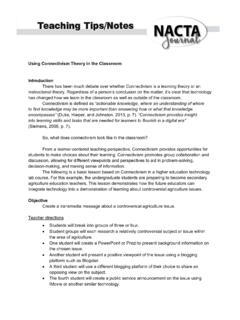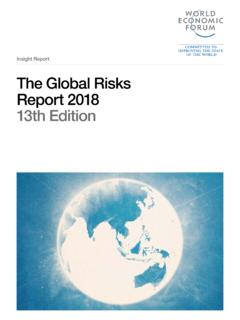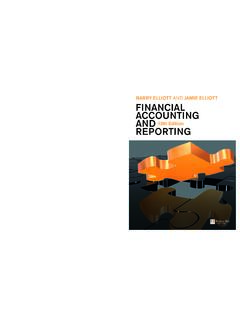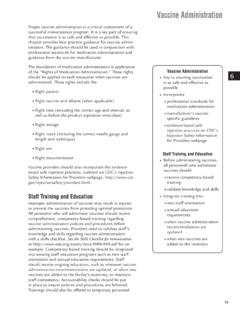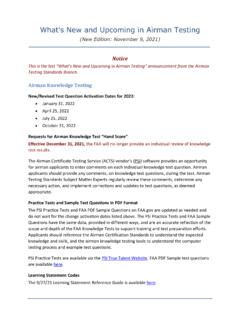Transcription of The Lecture Method
1 Preliminary data on student reaction to the use of time lapse movies in crop science teaching indicate that students agreed that such movies (1) satisfied course ob- jectives, (2) should be used in the course, (3) led to better understanding of the course, (4) have a definite place in the classroom, (5) improved the course. (6) should be used during course lectures, (7) show crop growth more efiiciently than other media. (8) should be used more, (9) enhance learning, (10) should be increased in number, and (1 1) should be used in other courses: while they dis- agreed that time lapse movies are (1) useless, (2) less ef- fective than slides or blackboard drawings, (3) too imper- sonal, (4) inferior to videotapes as a teaching medium. and (5) conducive to sleeping in the classroom or labora- tory. Students tend to increase their conviction that time lapse movies have a definite rple and place in crop sci- ence teaching as more films are used.
2 REFERENCES ' Ariel. G. Method for Bimhen~ical Analrjis of Human Performance. Quonerly u/'rhr AIIICV-. Hc~crltlr. Physiccil Ed~icu- tiorr urtd Hccrrurion. (AAHPER) 45:72-9, March, 1974. Boulton-Hawker Films Ltd. and Educational Foundation for Visual Aids. 'The Looking at I'lants Series" (5 films) International Film Bureau Inc. Chicago. Illinois. March. 1975. INVITATIONAL PAPER The Lecture Method Thomas M. Sutherland Introduction I consider it a great honor to be invited to present this paper, which I had in fact prepared originally for presentation to our own faculty at in one session of our continuing series called "Let's Talk Teaching." Our President Bill Thomas was at that session and sug- gested we might well present it to in view of our vital interest in teaching and the use we all still make of the Lecture .
3 An old adage says that good teaching involves telling your audience what you are going to say, saying it, and then telling them what you said: I would like to bow to this saying today and start by giving you an idea of what you are about to hear. Fist it seems to me impossible to discuss intenigently the Lecture Method as a means of teaching without grappling somewhat with such ques- tions as "What is education?", "When is a man This inriiaiional papers was presented by Dr. Thomas Suthcrlnnd, Prnfessor of Animal Sciences. Colorado Siate Uni~ersily, during the 1976 NACTA Conference held at Texas Tech Unitersity. Lubbock, June 16-18. ' Crier. J. and R. C. Goss. lnexpensivc Apparatus for Time lapse Bid. Truch. Miirch. 1%4. Harlow. William M. Explorirrg ~cirh tlre Tirnr-lupse cunzeru. (A terl minute 16 mm. color sound film).
4 International Film Bureau Inc. Chicago. Illinois. May, 1968. 011. John. "You See Plants Grow by Time-lapse Photqraphy." Flmcur Groiver, XXXVI. January. 1949, pp. 40-41. Ott. John. "Some Responses of Plants and Animals to Variations in Wave Lengths of Light Energy." Arrrrcrls c!f'thc. New York Acotlc,r~rj~ q/' Vol. 11 7. Art. 1, Scptemkr 10. 1 %4. pp. 624-635. ' On. John. Explorirrg the Spectnmt (A 46 minute 16 nlm. color sound film) lnrernational Film Bureau Inc. Chicago. Illinois. June. 1975. Oft. John. Health and Light: The Etfcrts of Natural and Artificial Light on Man and other Living Things. Old Grecnich CT: Devin Adair 1973. Prior, T. and J. M. Cooper. Light Tracing Used as a Tool in Analy- sis of Human Movement. R tnseorch Quuner[v of tlre A ~r Associatiotr for Heulrlr. PIysicalEdrrcatiorr urrd \Yl~l/ure.]
5 39531 5- 17. October. 1968. 'O Rich. C. L. Super-8: Its Now a Real Consideration for Flimnlakcrs. Av. Irrstr. 19: 15-16, March. 1974. " Smith. G. R. Time Lapse Camera Records Science Teaching. Sck. Sci. arrd Moth. 63573-5. October, 1963. l2 Smith. G. R. Classroom Teaching in Memomation. Peuhdy J. Ed. 11:33-5. July. 1963. l3 Walton. J. S. High Speed Timing Unit for Cinematography. srurclr Qrrorrer!v oJ' tltr* A tttericutr Associcrtiwr ,/iw Hcaltlr. Plrysiccrl Educcrtior~, or~d Recrr~crtiort. 41:213- 16. May. 1970. '* Zuckerman. Sir Solly. "Light and Living Matter." Trotter-P; ~ Memorial Lecture . 'Transaction of Illunlinating Engineering Soci- eiy. London. Vol. 24, No. 3. 1959. educated?", "What is so-called 'good' teaching?", and "How do we evaluate teaching?". So I will throw out to you some ideas on this subject after which I will get to the heart of today's topic of the Lecture Method with a defini- tion.
6 Some history, a discussion of the pros and cons and an analysis of the Lecture Method as it is used today. Finally I will try to set up a model of the "good Lecture " and suggest some reconlmendations on how it can be put into effect! Ideals of Education and Good Teaching First then in a look at education in general, we can say and I hope agree that the fundamental aim of education is not just the training of a skilled technician or a competent professional-broadly stated, it is rather the furthering of good citizenship. Dewey says, "The aim of education is to further discipline, natural develop- ment, culture and social efficiency. which are the marks of a worthy member of society." Whitehead puts it even more loftily when he says, "The aim of education is un- derstanding..in the sense that to understand all is to forgive all.
7 " The basic purpose of a university then is to prepare the nation's youth for a life in which they can contribute not only to the maintenance but also to the furthering of society. The university, through the education provided, should help students to discover and develop their capacities for self-realization: it does so by providing opportunities for contact between the minds of students and professors and in so doing presumably ex- poses them to the very loftiest ideals of our culture. NACTA Journal - September 1976 The very word, "education." comes from the Latin words e ducere, which mean to draw out. We are told that this is indeed what Socrates did, with his students around him - they talked while he interrogated and guided their discussion in the proper channels. The stu- dent then is the center of the educational process - the teacher takes the student as he finds him and helps him reach the highest levels of achievement of which he is capable.
8 The ideal of the university which is here presented as the means by which this education is accomplished is not simply as a teaching institution; it is rather a center of learning, a community of scholars constantly experienc- ing themselves the excitement of learning. It is from such a community of scholars that the student discovers and learns that essential ingredient of true education - the inquiring mind carrying on independent study. That con- tankerous Irishman. George Bernard Shaw, once said. "If you teach a man anything, he will never learn." The picture of the ideal scholar-teacher which emerges then, is of a man (or woman) of intellectual and moral stature with a positive view of life; he believes and conveys to his students the belief that it is possible for a man to acquire a sense of achievement plus a high degree of fulfillment of his potentialities.
9 He is not only a scholar but is capable of becoming enthusiastic about his subject and can reveal that enthusiasm and inspire his students. He is one who cares genuinely whether or not students learn by showing his concern for their progress. He does not assume that telling is teaching but realizes that the student learns as much from contact with the teacher himself as from what he says. In this regard Emerson has said. "The man may teach by doing and not otherwise. If he can conlmunicate himself. he can teach, but not by words. He teaches who gives, and he learns who receives. There is no teaching until the pupil is brought into the same state or principle in which you are; a transfusion takes place: he is you and you are he; then is a teaching and by no unfriendly chance or bad company can he ever quite lose the benefit.
10 " Now it is in translating these foregoing rather lofty ideals to the practical and real terms of the university today that conflict and problems emerge. The growth of our tremendous industrial and specialized economy and society has put demands on the universities for quantities of "trained" graduates. and education is in a constant state of flux. An ever-increasing quantity of knowledge must be dispensed. and an ever-increasing percentage of high school graduates is entering the institutions of high- er learning with the result that the average ability of the university student must be decreasing. In light of this last fact the professor may no longer be able to present him- self as "exhibit A" in favor of education and to teach by example, exhortation. and inspiration. whereupon the students rush eagerly to the library to try to emulate such a paragon of' virtue and scholarship!
